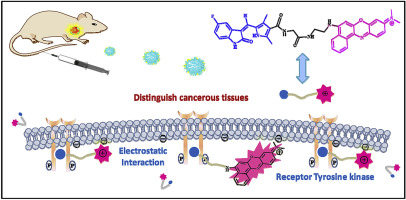当前位置:
X-MOL 学术
›
Biosens. Bioelectron.
›
论文详情
Our official English website, www.x-mol.net, welcomes your
feedback! (Note: you will need to create a separate account there.)
Ionic fluorescent sensor targeting receptor tyrosine kinases for biosystems imaging and application in flow cytometry.
Biosensors and Bioelectronics ( IF 10.7 ) Pub Date : 2020-01-15 , DOI: 10.1016/j.bios.2020.112026 Jiqiu Yin 1 , Yang Jiao 2 , Xiaojun Peng 2 , Haiyang He 2 , Chunying Duan 2
Biosensors and Bioelectronics ( IF 10.7 ) Pub Date : 2020-01-15 , DOI: 10.1016/j.bios.2020.112026 Jiqiu Yin 1 , Yang Jiao 2 , Xiaojun Peng 2 , Haiyang He 2 , Chunying Duan 2
Affiliation

|
Fluorescent imaging of receptor tyrosine kinases in living biosystems is an important means for the early diagnosis of cancer, herein an ionic fluorescent sensor (SNB) composed of targeting unit (sunitinib) and nile blue fluorophore linked via long flexible chain has been designed and evaluated. The SNB sensor exhibits distinct fluorescence responses to receptor tyrosine kinases derived from unfolding strategy and targeting ability, which were evaluated through 2D NMR analyses, optical studies, kinase activity assays. The SNB sensor has excellent membrane fluorescent imaging by electrostatic adsorption and can selectively insert into receptor tyrosine kinases domain pocket on the membrane of cancer cell lines. The SNB sensor has been successfully applied in flow cytometry for cell sorting and fluorescence imaging with tumor mouse model in vivo. The SNB senor may help transition the technology into a widely suitable tool for flow cytometry, imaging with confocal microscopes, whole animal imaging and possibly facilitating early diagnoses and treatment of cancer.
中文翻译:

靶向受体酪氨酸激酶的离子荧光传感器,用于生物系统成像以及在流式细胞仪中的应用。
活体生物系统中受体酪氨酸激酶的荧光成像是癌症早期诊断的重要手段,本文设计并评估了由靶向单元(舒尼替尼)和通过长柔性链连接的尼罗蓝荧光团组成的离子荧光传感器(SNB)。SNB传感器对受体酪氨酸激酶表现出独特的荧光反应,这些信号来自展开策略和靶向能力,这些反应通过2D NMR分析,光学研究,激酶活性分析进行了评估。SNB传感器通过静电吸附具有出色的膜荧光成像,可以选择性地插入癌细胞系膜上的受体酪氨酸激酶结构域口袋中。SNB传感器已成功应用于流式细胞仪中,用于体内肿瘤小鼠模型的细胞分选和荧光成像。
更新日期:2020-01-15
中文翻译:

靶向受体酪氨酸激酶的离子荧光传感器,用于生物系统成像以及在流式细胞仪中的应用。
活体生物系统中受体酪氨酸激酶的荧光成像是癌症早期诊断的重要手段,本文设计并评估了由靶向单元(舒尼替尼)和通过长柔性链连接的尼罗蓝荧光团组成的离子荧光传感器(SNB)。SNB传感器对受体酪氨酸激酶表现出独特的荧光反应,这些信号来自展开策略和靶向能力,这些反应通过2D NMR分析,光学研究,激酶活性分析进行了评估。SNB传感器通过静电吸附具有出色的膜荧光成像,可以选择性地插入癌细胞系膜上的受体酪氨酸激酶结构域口袋中。SNB传感器已成功应用于流式细胞仪中,用于体内肿瘤小鼠模型的细胞分选和荧光成像。











































 京公网安备 11010802027423号
京公网安备 11010802027423号